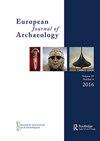An Experiment Measuring Water Consumption in Roman Hydrophobic Mortar (opus signinum)
IF 1.2
2区 历史学
0 ARCHAEOLOGY
引用次数: 0
Abstract
测量罗马疏水砂浆耗水量的实验(opus signinum)
Opus signinum 是一种石灰砂浆混合物,其中包括作为骨料的碎陶器。由于它具有防水性,因此被用来衬砌水池和渡槽等水工建筑物。虽然过去有许多罗马 "混凝土 "的再现,但疏水内衬却很少受到关注,所有这些再现的初步研究都更多地关注干燥成分和石灰,而不是灰泥的水性需求。本文介绍的实验是在传统建筑工人的帮助下,更好地了解憎水衬里的混合和应用过程,并计算各个样本的耗水量。所获得的数据有助于评估罗马建筑工地的用水需求、这些用水量所需的相关物流以及应用这种特殊类型衬砌的技术性。
本文章由计算机程序翻译,如有差异,请以英文原文为准。
求助全文
约1分钟内获得全文
求助全文
来源期刊

European Journal of Archaeology
ARCHAEOLOGY-
CiteScore
3.40
自引率
6.70%
发文量
58
期刊介绍:
The publication organ of the European Association of Archaeologists, the European Journal of Archaeology seeks to promote open debate amongst archaeologists committed to a new idea of Europe in which there is more communication across national frontiers and more interest in interpretation. The journal accepts not only new empirical data and new interpretations of the past but also encourages debate about the role archaeology plays in society, how it should be organized in a changing Europe, and the ethics of archaeological practice. All periods are covered; papers, review articles, interviews and short "debate" pieces are all sought. Whilst English is the primary language of publication in the EJA, papers submitted in French or German will be given equal consideration.
 求助内容:
求助内容: 应助结果提醒方式:
应助结果提醒方式:


